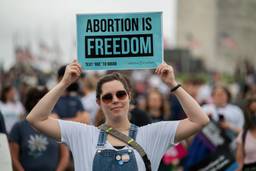Poverty Is a Public Policy Choice
Pandemic safety net programs kept millions out of poverty in 2021. Cutting them will lead to more unnecessary misery.
Asha Banerjee and Ben Zipperer

It should not have taken a pandemic to realize poverty is a public policy choice.
Public investments in safety net programs continue to be extremely effective poverty reduction tools, as newly released Census income data show. Government social programs kept tens of millions of people out of poverty in 2021. Because of expansions to programs like unemployment insurance benefits and the child tax credit, poverty rates were actually lower in 2021 than they were prior to the Covid-19 pandemic.
The poverty reduction achieved through expanded social insurance programs highlights how much policymakers’ choices can impact poverty.
Unfortunately, some of the program expansions enacted in the pandemic have already been reversed, and cuts to programs like unemployment benefits and the child tax credit will increase household economic distress going forward.
Last year, Social Security had the largest anti-poverty impact, reducing the number of people in poverty by 26 million. Recent policy expansions including refundable tax credits, like the earned income tax credit (EITC) and child tax credit (CTC), and economic impact stimulus payments also reduced the number of people in poverty by roughly 10 and 9 million people respectively.
As Figure A shows, the third and final economic impact stimulus payment was measurably effective in alleviating economic distress, keeping close to 9 million people from poverty. The stimulus payment likely reached many who were ineligible for Social Security, the EITC, or CTC and who were still struggling from the effects of the pandemic shock to the economy. The sheer number of people this program supported underscores the success of direct income support programs.
Another example of successful expansions to economic policy programs is the refundable tax credits, which include the EITC and CTC. These programs kept close to 10 million from poverty. The CTC benefit amounts were increased and made fully refundable in 2021 and have kept over 5 million people from poverty. Despite a remarkable reduction in child poverty in 2021, policymakers let the refundable CTC expire in December 2021.
Census estimates show that unemployment insurance (UI) benefits kept 2.3 million people out of poverty in 2021. Prior to the pandemic, the UI system was much less effective at poverty reduction because of uneven state-based implementation, restrictive eligibility requirements, and relatively stingy benefits. But in 2020 and 2021, the UI system began to play an unprecedented role in reducing economic distress after Congress passed temporary extensions, including expanded eligibility for those with low incomes and independent contracts, longer benefit durations, and additional benefit amounts like the $300 supplement that expired mid-year. Ending these expanded programs in the middle of 2021 sharply reduced incomes and the consumer spending they bolstered.
Notably, Census figures likely undercount the actual poverty reduction due to unemployment benefits. As in previous years, Census surveys severely underestimate unemployment benefit receipt. In 2020, the Current Population Survey that underlies these income and poverty measures captured less than half of the unemployment benefits reflected in administrative records. It is likely more complete data would show many millions fewer people in poverty as a result of receiving UI benefits.
The Census poverty data offer strong evidence that millions were still experiencing economic hardship and financial insecurity throughout 2021. Despite the Covid-19 recession only officially lasting three months according to the National Bureau of Economic Research, the economic pain lingered. The sheer number of people who needed these programs offers a strong rebuke to those who claimed that economic recovery legislation like the 2021 American Rescue Plan was unnecessary spending.
Looking forward, policymakers must continue to prioritize poverty reduction and make these high-impact social insurance programs permanent rather than temporary. The United States has long lagged behind its international peers in spending on anti-poverty, social welfare, and family benefits, choosing to accept high levels of poverty as the status quo.
Racism has been a major barrier to expanding social insurance programs. Recent research shows that Americans consistently overestimate the share of Black people supported by government social programs, leading white Americans in particular to oppose many forms of social insurance. In addition, the temporary nature of the 2020 and 2021 expansions to government social programs suggests that, despite their huge success at reducing economic deprivation, many policymakers choose austerity over effective poverty reduction.
Social insurance programs kept over 25 million people out of poverty in 2021. Millions of low-income Americans were supported by new or expanded programs, such as the economic impact stimulus payments, the refundable child tax credit, and expanded unemployment insurance. Given the overwhelming effectiveness of these programs in keeping people out of poverty, it is unconscionable that policymakers have allowed them to expire and added to the stress of low-income families in the years to come.
This story was first posted at the Economic Policy Institute.
Asha Banerjee is an Economic Analyst at the Economic Policy Institute.
Ben Zipperer is an Economist at the Economic Policy Institute. His areas of expertise include the minimum wage, inequality, and low-wage labor markets.





